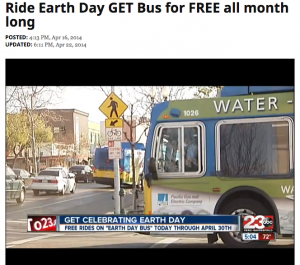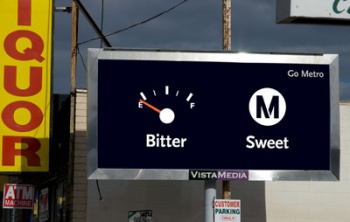Difference between revisions of "Marketing strategies"
(added photo) |
|||
| Line 1: | Line 1: | ||
| + | [[File:Bakersfield-earth-day-2014.png|thumbnail|Screenshot of local news coverage of Golden Empire Transit promoting free bus rides all month to celebrate Earth Day, 2014.]] | ||
| + | |||
[[Category:Market Response]] | [[Category:Market Response]] | ||
Revision as of 01:32, 24 April 2015
Introduction
Major automobile companies spend billions of dollars each year on marketing. In 2009, General Motors alone spent $3.2 billion on advertising campaigns [1]. In contrast, public transit agencies tend to focus more on technical and financial aspects, leaving marketing as an afterthought. However, a good marketing strategy can help transit agencies attract new riders, maintain existing ridership, and build positive public perception and political favor.
EMBARQ Marketing Guide
EMBARQ published a handbook to help transit agencies develop strong marketing strategies, with a specific focus on bus rapid transit. The guide describes eight basic marketing, branding, and communications principles that are used in the private sector, and applies them to the public transport sector:
- Brand and identity
To create a successful brand, the agency should first define its core values and what it wants to emphasize about its services, such as modernity, efficiency, speed, reliability, comfort, convenience, safety, etc.
Example: When Los Angeles Metro opened the Orange Line, the city's first BRT corridor, the agency positioned it as an extension of the existing Metro system by using standard design elements, yet it had its own identity through the use of the color orange in all the marketing and communications materials.
- Internal communication
Every employee should be thought of as a brand ambassador. They are the ones most often interacting with customers, and thus are literally the public face of the brand. Effective internal communication strategies should not only let managers communicate values to the employees, but also allow employees to express ideas and concerns to high-level decision makers.
- User education
User education is crucial, especially when introducing new systems or changing existing services. Many customers are deterred by unfamiliarity, particularly discretionary riders who have the option to drive. Routes, fare collection, and the boarding process can all be daunting to a new transit user. Information kiosks, outreach in schools, trial periods, station ambassadors, and local news segments can all disseminate information about transit services.
Example: When the LA Metro Orange Line opened, the marketing team realized that people were unclear about what BRT was and how it differed from existing services. The team then anchored the marketing campaign with language that consistently began with "It's...", in order to point out all the new features of the service.
- User information systems
User information systems must help all passengers navigate the system with ease. Wayfinding signage, information kiosks, and other information systems should be placed in a way to help riders navigate their entire trip, rather than just at stations and stops. Signs, logos, color schemes, and other design elements should all be consistent to help riders create visual associations.
There are two common mistakes that transit agencies make when designing user information systems. First, they often inundate riders with too much information. Maps and time tables that show frequency are more useful for riders, as opposed to data-heavy timetables or maps with signs for every single stop. Different colors and line weights on a map can effectively convey information about frequency [2]. Conversely, a second mistake transit agencies make is not providing enough information. Designers for information systems need to think as novice riders, not as transportation planners.
- Marketing campaigns
Marketing campaigns can help attract new riders, and also build political and public support. This requires knowledge about the wants and needs of the customer base, which can be identified through market segmentation. Television ads, billboards, internet campaigns, and novelty items can help promote service.
Example: LA Metro's award-winning "Opposites" campaign and organizational rebrand increased discretionary ridership from 24% to 36% of riders, and it also helped pass Measure R. "Opposites" focused on simple word pairings, problem and solution, and was designed to be "quick read" with simple icons and messages. Additionally, the agency targeted trendsetters; they capitalized on a LA Weekly story that named the best baristas in the city, sending them "Opposites" t-shirts[3].
- Public relations and external communications
External communications are extremely important for transit agencies, since they can "control the narrative". Addressing problems proactively, rather than hiding them, and developing good relationships with the media can help steer the press coverage a transit agency gets, especially when there are major projects or changes.
Example: In preparation for the Orange Line launch, LA Metro developed an extensive public relations plan that built good will and portrayed a positive image of the project. The agency advertised the Orange Line heavily and was extremely proactive about distributing construction updates and notices.
- User feedback systems
There should be a feedback channel to allow riders feel their opinions are valued. Comment cards, surveys, or social media can all allow for both positive and negative feedback, which the transit agency can then incorporate into its plans.
- Online engagement
People now most often rely on the Internet for information that they need. There are many comprehensive online strategies, many of which can be implemented at low-cost: a well-designed and useful website, a social media presence, open data, and mobile applications. Websites should provide not only route schedules, but also information such as expected travel times, potential delays, or other information that could affect trip times and routes. Social media tools such as Facebook and Twitter can be powerful external communication tools, since their speed and popularity can keep riders up to speed on the most up-to-date information on service changes and construction developments. Opening data to third party developers can result in extremely useful mobile applications, interactive maps, and trip planners; many cities now use general transit feed specification which integrates transit information with Google maps.
Transit Marketing Plan for Mendocino County
Transit Planning LLC and Mobility Planners prepared a Short Range Transit Development Plan for Mendocino County. Mendocino County conducted market research, which revealed important market segmentation information such as overall ridership demographics, service issues, and characteristics of individual routes. This helped focus the marketing plan on areas where there would be the most benefit.
The report is specific to Mendocino County's transit needs, but there are several marketing recommendations which all transit agencies can consider.
- Improving printed guides and materials
The market research found that a large percentage of riders relied on printed guides, yet they found them difficult to read and understand. Recommendations included using color to differentiate routes, organizing the text in an easy-to-read layout, and clearly advertising the agency on the front of the brochure.
- Improving the website
The website was clunky and not very useful for new riders, with the exception of a Google Maps sidebar. The report provided basic tips on good website design, such as creating scannable webpages, better linkages to related pages, and an automatic translation function, such as Google Translator.
- Building customer relationships. The report also recommended the agency build better feedback and communication channels with its customers. Facebook, Twitter, and comment pages allows riders to share their experiences, complaints, and suggestions.
References
- ↑ EMBARQ "From Here to There: A Creative Way for Making Public Transport the Way to Go"
- ↑ Human Transit "Basics: The case for frequency mapping"
- ↑ Society for Environmental Graphic Design"Metro Opposites Campaign"
Additional Reading
EMBARQ. "From Here to There: A Creative Way for Making Public Transport the Way to Go". (2011).
- EMBARQ, a global company that focuses on sustainable transportation solutions, published a handbook that applies eight basic marketing principles to transit. The guide includes many examples and suggestions for transit agencies to improve their marketing strategies.
Mendocino Transit. "2012-16 Short-Range TRansit Development Plan". (2012).
- Transit Planning LLC and Mobility Planners prepared a Short Range Transit Development Plan for Mendocino County, which included detailed marketing strategy recommendations.

